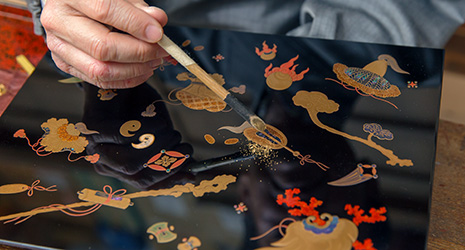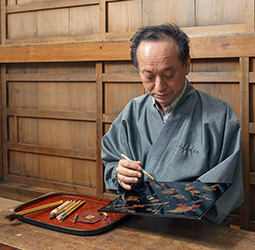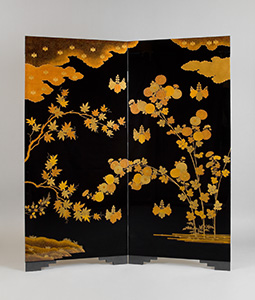INDEX
- English
- 日本語

Shimode Yutaro at work - English
- 日本語

Yukyu no Sasayaki (w. 240 cm x h. 60 cm x d. 50 cm), a decorative stand by Shimode on display at the Kyoto State Guest House

Shimode Yutaro at work 
A sixteenth-century makie screen restored using original techniques by Shimode Yutaro
October 2020
Gold, Silver, Platinum and Black: The Timeless Art of Makie

Makie is a technique developed in Japan in which kacho-fugetsu (traditional themes of natural beauty in Japanese aesthetics) and other scenes of the four seasons are created by sprinkling gold, silver or platinum powder over jet-black lacquer. The glittering effect continues to fascinate people around the world.

Makie is a handicraft that uses lacquer*. The origins of this craft remain unknown, but a work made more than 1,200 years ago still exists today**, and it shows the unique development of the craft in Japan over a long period of time. Christian missionaries from the West who came to Japan in the sixteenth century were captivated by the beauty of makie, and makie objects came to be widely known in the West due to their use in the church. Makie then charmed the royalty and nobility and they became highly valued. This is why makie and other handicrafts that use lacquer were often called “japan” in Europe and the United States. According to one theory, many pianos even today are a shiny black color because of the black of lacquer.
Shimode Yutaro is a lacquer craftsman who was born into a family of makie artists in Kyoto and is known for being the creator of Yukyu no Sasayaki (“Eternal Whisper”), a decorative stand which is placed at the Kyoto State Guest House. He says, “New value is created by creating a pictorial representation through the combination of materials with completely different properties: lacquer—organic matter made from sap—and gold or silver—inorganic matter. People are fascinated by the fact that this elaborate expression is created by hand.”

Makie involves decorating deep black and glossy lacquer with gold and silver powder, and sometimes platinum powder. Using the powder based on the shape and roughness of its particles, artists express the differences in distances in scenes and even the differences in light shining down from the sun and light reflecting off the surface of water. There are about eighty types each of gold and silver powder to create something so elaborate. The kacho-fugetsu and other scenes drawn change based on lighting and viewing angle, endlessly enchanting the eye.
Shimode says, “The black color, which is called ‘jet black,’ is a persistently deep black color, yet it offers not a coldness but a warmth. I think this is because the black of this jet black color contains a variety of reds or greens. The gold used in makie is not simply a ‘gold color,’ but produces a warmth through the use of the various eighty types of particles based on shape and size, and it can also produce profound feelings. I think that this balance leads to the beauty of makie.”

A representative work of Shimode, Yukyu no Sasayaki (“Eternal Whisper”), shows a reflection on the surface of water and produces harmony using 70,000 particles of platinum and gold powder. The sparkle that glitters out from among the jet black calls to mind a galaxy that exists among the macrocosm rather than the flow of water on Earth. It is as if you can hear a whisper from the eternal cosmos from the glitter of platinum and gold that stand out from the jet black.
* Lacquer is the sap harvested from the trunk of the Japanese lacquer tree or something that has been refined from this sap
** A decoration created by a technique considered to be the origin of makie is found on the sheath of a tachi sword, stored at Shosoin, made in the eighth century

